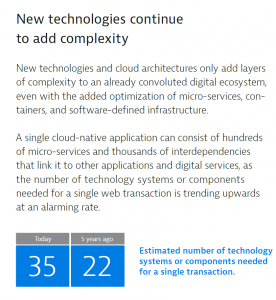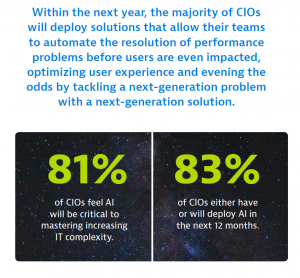We’ve just launched our new “Top challenges facing CIOs in a cloud native world” report, offering fresh analysis on a new global survey that asked CIOs about the biggest challenges they face in today’s IT ecosystems. It offers some great insights around:
- The areas of IT that will see the biggest investment over the next 12 months
- The impact that these technologies are having on the evolution of IT ecosystems
- How this evolution is contributing to soaring complexity and the challenges that creates for IT departments
The findings hit the mark because we’ve already had solid media traction in the last few days:
What did our research reveal?
It’s a pretty meaty study that really shines a light onto the biggest problem areas that IT is struggling with at the moment, so I’d recommend taking the time to read through the full report on your next coffee break. To whet your appetite in the meantime, some of the key findings were:
- 76% of CIOs said that rising IT complexity could soon make it impossible to manage performance efficiently and effectively
- IT teams spend 1/3 of their time fixing digital performance problems, costing their employers an average of $2.5 million every year – ouch!
- The average web or mobile application transaction today touches 35 different technology systems or components; compared to 22 five years ago – that’s a huge leap in complexity
- 53% of organisations will deploy new technology in the next 12 months, ramping up that complexity even more
- Multi-cloud usage and the switch to cloud native architectures are creating a particular series of headaches for CIOs

What does this tell us?
Ultimately, all this really underlines that IT ecosystems are becoming hyper-complex as we continue marching towards multi-cloud infrastructures and cloud native architectures, which constantly makes it harder to manage customer and user-experiences.
Unfortunately, that couldn’t be happening at a worse time.
We as consumers and employees expect technology to just work perfectly every time, and when it doesn’t we can be pretty unforgiving. But we forget that there’s no magic involved.
When we open our apps to check our social media feeds, log into our online banking service or use an in-store payment card reader; that’s setting in motion a whole chain of digital transactions and events that rely on the underlying IT ecosystem to make everything work.

The result is that the poor guys in IT feel like they have the weight of the world on their shoulders. They have to see everything that’s happening in their IT environment and identify the second that something goes wrong.
How do you get out of this nightmare?
So how do they keep tabs on everything in today’s world of hyper-scale, hyper-dynamic and hyper-complex digital ecosystems?
Our report shows that CIOs are looking at Artificial Intelligence (AI) for the answer. More than four in five think AI will be critical to IT’s ability to master IT complexity, which makes a lot of sense.

Identifying the root cause of any performance problems in today’s IT environments would be like trying to find a needle in a haystack for a human operator alone. Or, probably more accurately; like trying to find a needle in a data center full of haystacks that are all running around like headless chickens.
Instead, if they had one single, AI-powered, fully automated application performance monitoring solution that can see the full stack, they could afford to relax a little. Good job Dynatrace has them covered then!
If you want to grab your own copy in the meantime, head across to this page, and don’t forget to let us know what you think; it’s always great to hear from you.



Looking for answers?
Start a new discussion or ask for help in our Q&A forum.
Go to forum